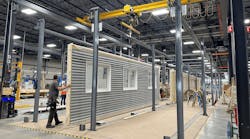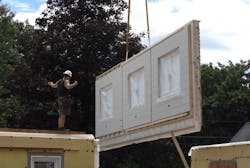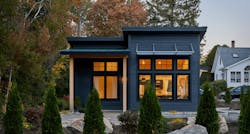6 Ways Off-Site Construction Can Boost Home Building Productivity
New innovations in off-site building construction have increased our ability to address the housing deficit currently plaguing the United States and Canada. Yet for the past decade, precut framing packages, panelized structural components, and volumetric modular construction combined have represented just 3% or less of new-home completions, according to U.S. Census Bureau data.
In my experience as a tradesperson, designer, home builder, and entrepreneur of new building technologies, I have seen how off-site construction methods can deliver better quality and more sustainable homes faster without adding material and costs.
3 Common Misconceptions About Off-Site Construction Methods
And yet, three common misconceptions stand in the way of widespread adoption of prefabrication, namely that it:
1.) Lowers construction quality
2.) Offers little or no ability to customize a home’s design
3.) Requires more complicated permitting and approvals
This article will not only address these common misconceptions of off-site construction but also will provide a clear lens into additional productivity and other benefits off-site methods provide to home builders and residential developers.
RELATED
- Home Builders, What's Your Off-Site Construction Super Power?
- Modular and Panelized Homes Market Share
- The Great Convergence, Part 1: Why the Move to Off-Site Construction Now?
The Benefits of Using Off-Site Construction Methods
1.) QUALITY: Off-site construction results in increased quality (and speed)
While outdated preconceptions question the quality of off-site building methods, industrialization actually requires and enables higher quality control.
The optimal environment of a factory setting results in quality that is at least equal to on-site stick-building methods, quality control that is far more than is possible on a construction site, and dramatically superior production speed that is measured in weeks instead of months.
The process also ensures that building materials are kept dry and of consistent quality. A factory setting also eliminates the back and forth of needing additional materials, as well as delays due to inclement weather or employee outages.
Utilizing a vertically integrated off-site factory shortens build time and streamlines the supply chain, as materials are often provided by one supplier on a far more regimented, manufacturing-driven timeline—compared to a site build where materials deliveries are far less reliable and a constant concern.
Off-site production improves overall cost control because there are fewer delays due to material availability, weather, and available labor. Factories also are able to purchase materials in larger quantities at lower costs, thus improving profitability for the builder or developer.
2.) APPROVALS: Off-site construction makes permitting and approvals faster and less complicated
A common misconception is that off-site construction makes the permitting and approvals process more complicated, but in reality, approvals are more organized thanks to a network of third-party permitting agencies authorized by states to conduct plan reviews and/or in-factory inspections.
In the factory, builds are engineered to local code and site structural requirements, are inspected by authorized independent or government agencies, and follow rigorous standards to prevent damage during transportation.
Also, once the prefab components are delivered to a jobsite, the process of connecting modules to one another and to local utility services, as well as weaving finishes into a finished whole, takes weeks instead of months. That ability also significantly limits construction noise and disturbances on site, which can be especially helpful in obtaining zoning permits.
3.) HEALTH AND SAFETY: Off-site construction methods improve worker and occupant health and safety
Off-site construction offers unique health and safety benefits for both the builder and the home’s occupants.
For the builder, the factory setting provides expansive safety features, reducing the risk of injury during the construction process. There’s also less danger on the jobsite with off-site construction, with far less need for ladders, power tools, lifting heavy materials, or working in inclement weather. This advantage provides a financial benefit as well, as builders may be able to reduce insurance costs due to the reduced risk of jobsite injuries.
The benefits for the occupant include a healthy, safe home for decades to come. Because these homes are produced in a climate-controlled factory, the off-site components are sealed in dry conditions. The wood, insulation, and other materials are never rained on, reducing the risk of moisture damage and mold growth within the structure, which can occur in on-site builds where the home is exposed to the elements during construction.
RELATED
4.) SUSTAINABILITY: Off-site construction methods enable home builders to building more sustainably
With 37% of carbon dioxide emissions coming from the built environment , reducing that carbon footprint is a top goal for the future of our industry.
However, sustainability is a three-part endeavor: the makeup of the building product; how you build it; and how the building performs. While manufacturers continue to innovate in creating materials and products that are more sustainable, off-site building production is key to helping improve the impact of the home building process.
Building in a factory setting also delivers better, more reliable air sealing and moisture control for the structure, while cut-offs from the factory process are reused in other buildings, dramatically reducing the amount of waste produced and the cost to dispose of it.
But doesn’t transporting the framing components or modules of an off-site house from the factory to a jobsite use a lot of fuel and contribute to emissions? Of course, but it is typically only one delivery taking place on one day versus traditional construction, where workers and trade partners drive back and forth to a jobsite for several months, often in large trucks delivering supplies multiple times over the course of the build.
When you add it all up, the carbon impact of off-site construction is much lower than that of a traditional jobsite, according to a recent report issued by the Supply Chain Sustainability School in the U.K.
5.) CYCLE TIME: Using off-site methods expedites the build process
Achieving the expedited time lines of off-site construction requires planning all details in advance, as well as early and frequent conversations between builders, developers, and providers to discern and agree on options, time lines, capacity, and service levels. Design decisions also must be finalized as early as possible in the process to align with the provider’s capabilities and builder and developer marketing and sales strategy.
Other essential early discussions include streamlining the delivery, such as access to the build site and existing structures that may affect the craning and placing process.
It also is important to have up-front conversations with lending institutions to ensure they’re able to keep up with the speed of the off-site time line, as draw payments can occur much faster than with a construction loan for a traditional build.
6.) FLEXIBILITY AND CUSTOMIZATION: Faster construction with off-site methods does not mean less flexibility in design
Lastly, questions and misperceptions about design flexibility and customization continue to rear their heads in opposition to the use of off-site construction building techniques. In fact, the use of prefabricated components creates endless possibilities for building design.
Panelized construction can be combined with traditional construction or even modular construction to achieve desired floor plans and architectural details while still achieving the benefits of faster construction.
There is no shortage of misconceptions surrounding off-site construction methods for housing production. The key to off-site construction’s progress and adoption as a tool for the building industry is continuing education to explain the benefits and dispel the myths.
More conversations through various media outlets, industry events, think tanks, and trade associations can help demonstrate that off-site construction methods are incredibly efficient, offering speed and quality, simplifying the supply chain, ensuring labor consistency, and resulting in a more sustainable approach to building construction.
Dennis Michaud is managing director of off-site solutions at CertainTeed/Saint-Gobain, leading the company’s solutions and services that increase quality, productivity, and building performance in the off-site construction segment. His career in residential construction includes stints as a tradesperson, designer, builder, and entrepreneur of new building technologies. He holds a Master of Architecture degree from MIT.


